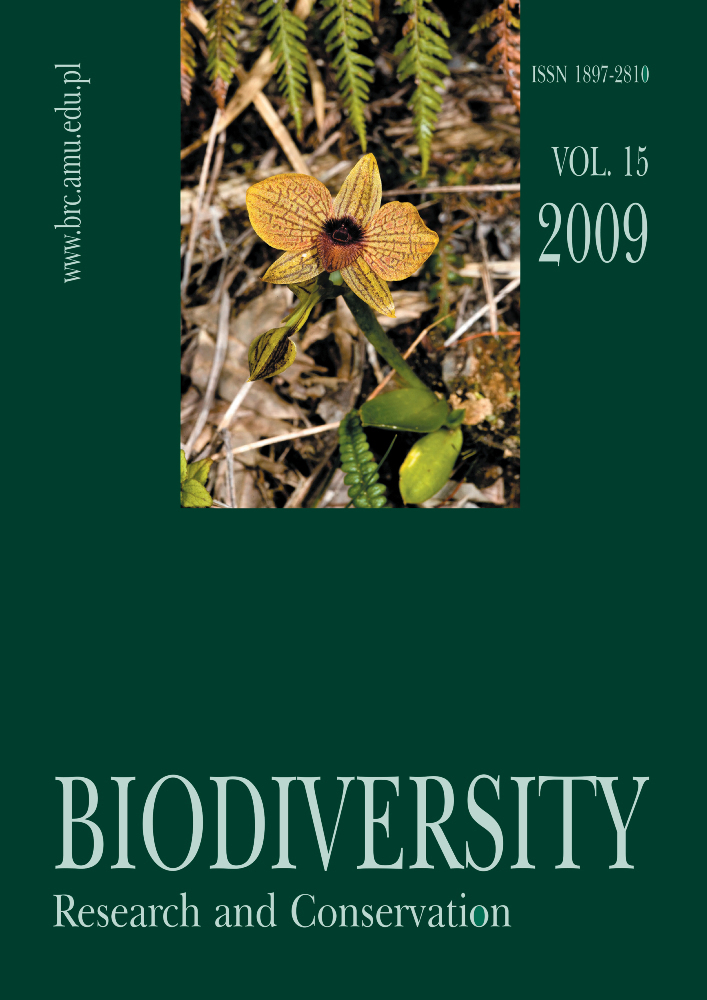Abstract
The method reflects proportions in the number of leaves of different sizes and shapes, which appear in a tree stand. The study was carried out during autumn leaf fall, in about a hundred years old tree stand, dominated by beech. Leaves were collected three times, altogether with assessment of foliage density. For all gathered leaves, the width and length were measured and the data were statistically analyzed. Differences among all three samples were significant, which indicates different size of falling leaves in the following periods. Thus, only the research carried on at the end of leaves falling allows collecting a sample which represents proportions among leaves of different sizes in the tree stand.
References
Barna M. 2004. Adaptation of European beech (Fagus sylvatica L.) to different ecological conditions: leaf size variation. Polish J. Ecol. 52: 34-45.
Beaudet M. & Messier C. 1998. Growth and morphological responses of yellow birch, sugar maple, and beech seedlings growing under a natural light gradient. Can. J. For. Res. 28: 1007-1015.
Białobrzeska M. & Staszkiewicz J. 1997. The variability of leaves of Corylus avellana (Betulacae). Fragm. Flor. Geobot. Polonica, Suppl. 2: 15-25.
Black-Samuelsson S. & Andersson S. 2003. The effect of nutrient stress on developmental instability in leaves of Acer platanoides (Aceracae) and Betula pendula (Betulacae). Amer. J. Bot. 90: 1107-1112.
Cowart N. M. & Graham J. H. 1999. Within- and amongindividual variation in fluctuating asymmetry of leaves in the fig (Ficus carica L.). Inter. J. Plant Sci. 160: 116-121.
Danielewicz W. 1993. Morfologiczna zmienność liści, owoców i łusek owocowych brzozy karpackiej (Betula carpatica Waldst. et Kit.) w Polsce. Rocz. Dendr. 41: 33-52.
Danielewicz W. & Maciejewska I. 1994. Zmienność wybranych cech morfologicznych brzóz z przeobrażonych siedlisk torfowisk wysokich okolic Chlebowa w Puszczy Noteckiej. Rocz. Dendr. 42: 23-36.
Frazer G. W. Trofymow J. A. & Lertzman K. P. 2000. Canopy openness and leaf area in chronosequences of coastal temperate rainforest. Can. J. For. Res. 30: 239-256.
Freenam D. C., Brown M. L., Duda J. J., Graraham J. H., Emlen J. M., Krzysik A. J., Balbach H., Kovacic D. A. & Zak J. C. 2005. Leaf fluctuating asymmetry, soil disturbance and plant stress: a multiple year comparison using two herbs, Ipomoea pandurata and Cnidoscolus stimulosus. Ecol. Indicat. 5: 85-95.
Hódar J. A. 2002. Leaf fluctuating asymmetry of Holm oak in response to drought under contrasting climatic conditions. J. Arid Environ. 52: 233-243.
Jack S. B. & Long J. N. 1991. Response of leaf area index to density for two contrasting tree species. Can. J. For. Res. 21: 1760-1764.
Jennions M. D. 1996. The allometry of fluctuating asymmetry in southern African plants: flowers and leaves. Biol. J. Linn. Soc. 59: 127-142.
Lempa K., Martel J., Koricheva J., Haukioja E., Ossipov V., Ossipova S. & Pihlaja K. 2000. Covariation of fluctuating asymmetry, herbivory and chemistry during birch leaf expansion. Oecologia 122: 354-360.
Lichtenthaler H. K., Buschmann C., Döl M., Fietz H. J., Bach T., Kozel U., Meier D. & Rahmsdorf U. 1981. Photosynthetic activity, chloroplast ultrastructure, and leaf characteristics of high-light and low-light plants and of sun and shade leaves. Photosyn. Res. 2: 115-141.
McDonald P. G., Fonseca C. R., McC. Overton J. & Westoby M. 2003. Leaf-size divergence along rainfall and soil-nutrient gradients: is the method of size reduction common among clades? Funct. Ecol. 17: 50-57.
Møller A. P. 1999. Elm, Ulmus glabra, leaf asymmetry and Dutch elm disease. Oikos 85: 109-116.
Nagamitsu T., Kawahara T. & Hotta M. 2004. Phenotypic variation and leaf fluctuating asymmetry in isolated populations of an endangered dwarf birch Betula ovalifolia in Hokkaido, Japan. Pl. Sp. Biol. 19: 13-21.
Niinemets Ü. & Kull K. 2003. Leaf structure vs. nutrient relationships vary with soil conditions in temperate shrubs and trees. Acta Oecol. 24: 209-219.
Osada N., Takeda H., Furukawa A. & Awang M. 2001. Leaf dynamics and maintenance of tree crowns in a Malaysian rain forest stand. J. Ecol. 89: 774-782.
Osada N., Takeda H., Kawaguchi H., Furukawa A. & Awang M. 2003. Estimation of crown characters and leaf biomass from leaf litter in Malaysian canopy species, Elateriospermum tapos (Euphorbiaceae). For. Ecol. Manag. 177: 379-386.
Premoli A. C. 1996. Leaf architecture of South American Nothofagus (Nothofagacae) using traditional and new methods in morphometrics. Bot. J. Linn. Soc. 121: 25-40.
StatSoft, Inc. 2001. STATISTICA (data analysis software system), version 6. www.statsoft.com
Svoboda A. M. 1972. Variability in leaves of European beech (Fagus sylvatica L.). 143 pp. Studie ČSAVZ, Praha.
Zar J. H. 1996. Biostatistical Analysis, 3rd edition. Prentice-Hall. London.




